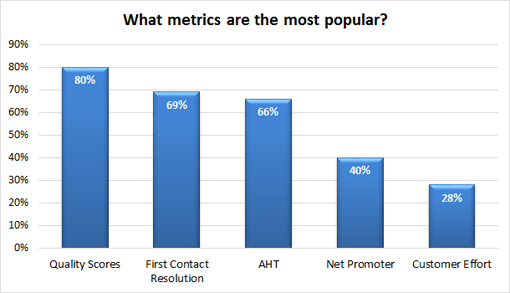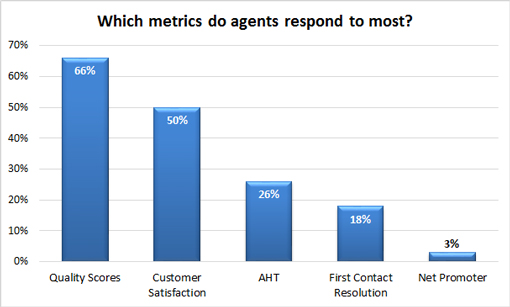We gathered opinions from across the industry to try and determine what the best metric for the contact centre really is.
What metrics are the most popular?
Data from the 177 attendees at 3/4/2014 webinar – The best metrics for your contact centre

What the experts say
There is no “one size fits all” solution to choosing metrics

Carolyn Blunt
While there is no “one size fits all” solution to choosing metrics, I do believe that any metrics are better than no metrics.
When deciding on which metrics to use, you should base your decisions on the wider goals of your organisation, and make a conscious effort to blend process and outcome metrics for a more balanced perspective.
Most importantly of all, make sure you do something with the data that you extract from using your metrics. Don’t just write up reports! Derive actions for improvements and use this information to improve your customer and agent experience.
With thanks to Carolyn Blunt, Managing Director at Real Results Training Ltd.
Select a balanced metric that maps your end-to-end process

Paul White
While an individual metric does have a value, it is best not to focus on one. Instead, you should select a combination of task-related (e.g. AHT and Sales Volume) and performance-related metrics (e.g. NPS and Customer Effort) that support your overall business objectives.
Before deciding on which metrics to use, you should also consider how your departments are interlinked. This is because metrics in one department can be to the detriment of the end-to-end process.
For example, an agent focusing too much on AHT may choose to pass a simple problem on to another department rather than spend time resolving the issue over the phone. Decisions such as these could be leading to extreme elevations in cost such as sending an engineer out to fix a simple problem.
With thanks to Paul White, CEO at mplsystems
Pool your key metrics into a single overall score that you can track
Rather than picking just one metric, you could try pooling all of your key metrics together into a single overall score that you can track. Alex Loach wrote a good article on this – Designing a single contact centre metric to improve performance – and called it the Authentic Core Linkage (ACL) score.
The idea is to look at every contact centre metric that you have at your disposal, and weight them based on importance to give you an overall weighted score/percentage. This approach will give you a truly personalised measure of your contact centre’s performance.
When selecting the metrics to include in your combined metric, I believe it is important to include both an agent and a customer-focused metric in the mix. I would also prioritise First Contact Resolution and the Customer Effort score in my selection.
With thanks to Jonty Pearce, Editor at Call Centre Helper
Which metrics do agents respond to most?

Data from the 177 attendees at 3/4/2014 webinar – The best metrics for your contact centre
It is interesting to note (when comparing the two graphs) that there is a clear disconnect between the metrics which are most popular and those which drive agent behaviour, especially on First Contact Resolution and NetPromoter.
Which metrics have worked best for our readers?
“Calls per hour” has worked well
Calls per hour has worked surprisingly well and agents have said they like this!
With thanks to Mark
We measure “available” time vs “not ready” time
We measure agent “available” time vs “not ready” time and that has worked well.
With thanks to Kris
Removing AHT worked for us
Removing AHT as a metric really worked for us.
With thanks to Eileen
Focus on performance metrics that agents have complete control of
I have had success with focusing on performance metrics that agents have complete control of. For example, their phone monitor scores.
With thanks to Angela
Measure effort to improve service
We measure Effort because the scores and feedback gives us something we can actually act upon to improve service.
With thanks to Fiona
They all work… if you take the time to explain the results
I have found that almost all the metrics work quite well.
But only if you explain the formula, drivers and results to the agents.
With thanks to Julian
Quality scores have really worked
Quality scores have really worked, using a range of scenarios which agents are marked against.
With thanks to Ian
Calls per hour and agent productivity both work well
Calls per hour and agent productivity are both working well for us right now.
With thanks to Gail
Asking the customer “how friendly was your advisor?” worked for us
The one that gained the best customer and agent reaction was simply asking the customer how friendly the advisor was – this was important for our values.
With thanks to Mark
Measuring “After Call” time has worked well
Measuring “After Call” time has worked well.
With thanks to Jack
Moving away from AHT improved call quality
Quality is one of our most focused on metrics in the centre.
By focusing on the back end of the AHT (work time) and taking the pressure off of the agents to rush off the phone, we found the agents were less stressed and the quality of the call remained high or improved.
With thanks to David
We moved AHT to be a team target, which went down well
We also split AHT to say 80% talk time and 20% wrap-up, and measured the 20% which is in the advisors’ control.
With thanks to Catherine
We have found success with monitoring quality alongside AHT
We have found success with monitoring quality alongside AHT and individual productivity (number of calls handled).
With thanks to Vanessa
We measure after-call work time as a percentage of handle time
The focus on this has naturally reduced our Average Handle Time without impacting our talk time/FCR.
With thanks to David
Which metrics have not worked?
AHT and Schedule adherence have not worked
Assessing quality has worked, while AHT and Schedule Adherence has not.
With thanks to Annette
Personal metrics have worked better than non-personal metrics
I have found that things that have worked are Quality Control and Talk Time, as they are personal, whereas abandon rate and call answer time in seconds don’t work, as these are not personal.
With thanks to Sue
Revenue per call has worked better than AOV
Revenue per call has worked for us better than AOV (Average Order Value) or Total Sales.
With thanks to Paul
Measuring “wrap time” didn’t work
Measuring “wrap time” didn’t work.
With thanks to Jane
AHT puts too much stress on the agents
I have found that using Average Handling Time as a metric puts too much stress on the agents.
With thanks to Tea
What do you think is the best metric for the contact centre?
Author: Megan Jones
Published On: 9th Apr 2014 - Last modified: 13th Jan 2025
Read more about - Customer Service Strategy, Carolyn Blunt, IFS, Metrics, Stress





































Quality scores are always number 1 for us, a reflection on the results of both surveys carried out. It has the greatest potential to improve agent behaviour.
Remove AHT and only focus on quality as a metric. Agent engagement is no.1 for excellent customer service.